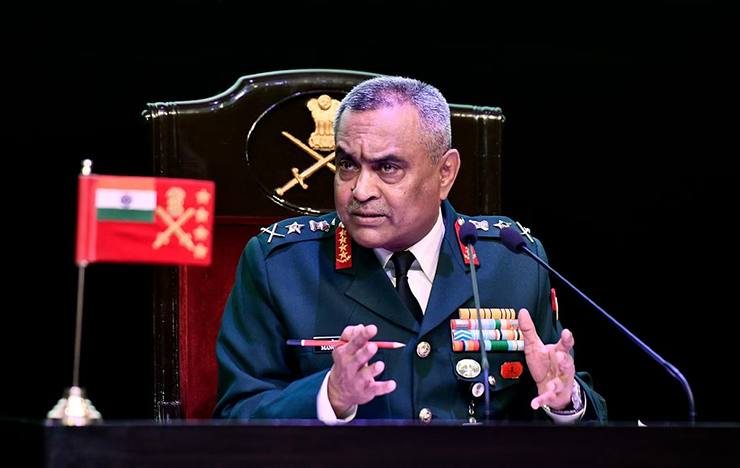
New Delhi: Ahead of the Army Day 2024, the display of in-house innovation, indigenisation initiated by the Indian Army at the Manekshaw Centre was impressive. Having declared 2024 as the Year of Technology Absorption, the exhibits signified a focused commitment to incorporating and harnessing technological advancements.
During the press conference on January 11, Army Chief General Manoj Pande elucidated the Army’s steadfast dedication to development, innovation, and the integration of niche technologies. The objective is to propel the Indian Army into a modern and agile force, with a pronounced emphasis on indigenisation. He emphasised the pivotal role of technology as a catalyst for transformative change.
General Pande said that the theme underscores our commitment to leverage technology as a catalyst for transformative change, as well as to utilise in-house expertise to innovate solutions to our operational and logistic requirements and give shape to these projects in collaboration with the domestic defence industry.
Emphasising the paramount importance of national interests and the established relevance of hard powers in this dynamic scenario, the Army Chief acknowledged that disruptive technologies as the new arena of strategic competition underscores the evolving landscape in which the Indian Army operates. “The security forces are resolutely aligned to ensure a stable and secure environment for the nation,” he said.
Revealing the significant aspect of the Indian Army’s foray into cyberspace capabilities, General Pande pointed out that the Indian Army personnel are being trained to leverage technology and exploit the cyber domain effectively through institutionalised, procedural, and technological measures. In this initiative, Project SAMBHAV takes centre stage while presenting an end-to-end secure mobile ecosystem operating on contemporary 5G technology. This project is positioned as a substantial leap forward in enhancing India’s defence capabilities. As part of the project, a total of 35,000 handsets for an end-to-end secure mobile ecosystem, will be configured in the next five months while 2,500 have already been rolled out.
“We have identified 355 Army posts from where we have asked for 4G connectivity with the telecom ministry. Infrastructure also has to do with forward airfields, villages, and helipads. We are also working on underground storage. Regarding the infrastructure along the LAC, we are progressing in all domains,” General Pande stated.
The Army has indigenously developed cellular phones, which use dual-use infrastructure under the project ‘Secure Army Mobile Bharat Version’ (SAMBHAV) ecosystem. The aim is to leverage the potential of indigenous public cellular networks in the country. SAMBHAV will be having multi layered encryption with Pan India Secure eco system. The phones will have an indigenous operating system with a multi-layered encryption, which has been developed in collaboration with the centres of excellence in both academia as well industry, including IIT-Madras. The ecosystem will use 5G-ready handsets using multi-tier encryption. It scrambles data which can be read only by authorised parties using a secret code, enabling the mobile phones to ride on a commercial network with inherent security.

Indian Army’s efforts to enhance technological capabilities extend to restructuring initiatives, encompassing both the artillery and electronic warfare units. “We have restructured our artillery unit and also have restructured units of electronic warfare and electronic intelligence,” General Pande detailed. Optimising the Army’s strength is a key focus. The transformative human resource initiative aims not only to provide productive employment for retiring soldiers but also to empower veterans.
The Indian Army places a strong emphasis on fostering creativity at the unit level. The Army Design Bureau (ADB) has identified and selected 34 out of 80 in-house innovations. These innovations span a spectrum of cutting-edge technologies, including AI, software applications, unmanned aerial platforms, and counter-drone systems. The collaborative approach involves partnering with academic and industry entities to develop ruggedized solutions meeting military-grade standards. The Army Design Bureau’s initiatives extend to integrating the capabilities of the entire defence industry ecosystem. Collaborations with premier academic expertise, such as the Foundation for Innovation and Technology Transfer, IIT Delhi, resulted in the identification of fifteen niche tech innovations last year. Eight of these initiatives have already undergone the Intellectual Property Rights (IPR) process.
Key Innovative Exhibits
The display of hybrid anti-drone system that includes an indigenous jammer integrated with an upgraded Russian-origin Schilka Weapon System caught immediate attention. Developed by Major Nagaraj SY and his fellow soldier Mohammed Firoze Khan, the system can be used effectively against swarm drone attacks. The Schilka Weapon System can track any incoming drone from a far distance which can be taken out using both kinetic and non-kinetic systems.
In continuance with its collaborative effort with academia, four niche tech innovations are currently in progress under the guidance of faculty from IIT Delhi through the Army Technology Board route. One notable success in this innovation journey is “Vidyut Rakshak,” an IoT-based Generator Monitoring and Control System, which has transitioned to the Indian industry for mass production.
In addressing the labour-intensive and time-consuming aspects of intelligence data collection, an AI-driven software has been developed. This software provides dynamic graphical representation, offering informative graphs that reveal hidden trends and patterns, thereby enhancing situational comprehension.
Another significant stride in innovation is the Military Objects Detection System in Satellite Images. This AI-based system enables the automatic detection and classification of military objects in satellite imagery in real-time. The developed AI module enhances Intelligence, Surveillance, and Reconnaissance capabilities, empowering commanders at all levels to make timely decisions.
Similarly. a new type of artificial intelligence-enabled and human-in loop land mine system developed by Major Rajprasad was noteworthy. This AI enabled mine system gets activated only with own troops’ intervention and can also help in saving the lives of own soldiers while crossing minefields on way towards enemy areas.
The in-house research and development efforts of the Indian Army have also given rise to the Multipurpose Octocopter. This versatile tool, with a payload capacity of 25 kg in high-altitude areas, serves various functions. It facilitates the delivery of essential supplies to forward posts, conducts surveillance operations, and offers a live camera feed to the operator. Additionally, it features a platform for firing assault rifles and throwing grenades, showcasing its multifaceted utility.















